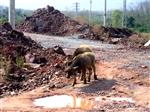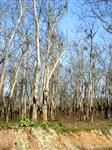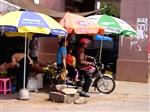- Getting around Lijiang. Dont stay in the Old Towns more than 2 days, there is nothing to do. KRISS Oct 9, 2013 05:46
- 2013 Beijing Temple Fair BENNYLAU Feb 26, 2013 03:29
- Malaysian traveling from KUL - LAX vis Shanghai PVG ZATI_DY Jan 3, 2013 20:15
Hidden in the Highlands
- Views: 5052
- |Vote: 0 0
- |Add to Favorites
- |Recommend to Friends
This would seem to be a misnomer until you visit this island of delightful contrasts. The highlands of Hainan are a world away from the tropical beach resorts surrounding Sanya, the bustling commercial capital of Haikou and the various fishing ports along the coast. The islands background and history has long nurtured an interesting mix of minorities sharing many common interests, occupations and locations. With the isolation and seclusion that the highlands of Hainan have offered many of these people groups it is not surprising to find that communication is sometimes more difficult than one might expect. Many villagers speak only their own dialects and seldom see outsiders.
Hainan Island, just south of the Tropic of Cancer, lies in the warm belt of tropical waters between the tropics and the equator. With an altitude of several hundred meters above sea level the highlands are often shrouded in low misty clouds all year round. These warm moist conditions year round are ideal for growing both tropical and temperate fruit. So it’s not surprising to discover that the island grows much of China’s tropical fruit including pineapples, bananas, papaya, mangoes, fire dragon fruit and coconuts.
Coconut plantations, just one the islands major tourist attractions grace the northern coastal regions. In the past rubber and more recently coffee plantations have been established in the cooler highlands of the islands interior. The low-lying west coast of the island, falling in a rain shadow, has a much drier climate and poorer economy and consequently far less visitors. Sanya and her now famous beaches is often all that many visitors see.
A road stretches the length of the islands interior running through rich red soil farmlands and shabby villages in the coastal lowlands in the north before climbing slowly into the hills where farms give way to remaining tracts of original forest, orchards and plantations. Heavy and consistent rainfall and the rich volcanic soils of the highlands support the lush sub-tropical vegetation and the highly productive rubber and coffee plantations. Several of the islands largest cities lie in these slightly higher altitudes.
In an effort to escape the crowds and inflated prices I travel from Haikou along the northwest coast to Lingao Cape before heading inland to Danzhou the largest city in the highlands. It’s a small modern town with the cleanest, cheapest hotel I will stay at during my trip. I arrive early enough to take a daylight walk around town and window shop but it’s not long before I encounter a pick pocket. When the hair on the back of my neck prickles I turn to find him right behind me just taking his hand from my bag. The only thing he gets from me is a slap across the face.
My next stop is Qiongzhong where I eat lunch and change buses for Tongzha or Wuzhishan. Travel from Danzhou has been slow, winding through the heavily wooded mountains, and passing through the occasional small village. From Qiongzhong the road climbs into the Wuzhi Shan 五指 山 Five Finger Mountains which offers a strenuous hike up the highest peak at 1,867 meters for good views on a clear day. I skip the hike, enjoying instead the limited view of the cloud shrouded mountains.
154 streams issue from these mountains. Swift in flow and short in length the island has only three large rivers none of which are navigable but provide a reliable source of water for irrigation and drinking. The town of Wuzhishan tucked into the valley beside a river is small and tidy but has is the worst hotel I stay in on this trip. It’s a tired old place opposite the bus station and after seeing the room and discovering that the toilet works none too well I show the manager a photo of the hotel from the night before, I suggest that he give me a discount. He doesn’t hesitate. I think he wants my business and to my surprise there is an internet café on the second floor which saves me looking for one outside.
At the colourful street markets you’re sure to see some of the Li and Miao minority who come in from their villages in the surrounding hills to shop and trade goods. The broad dry river bed is flanked with a boardwalk shaded by large densely canopied trees. Outdoor teahouses abound in the slightly cooler climate of the highlands attracting mostly men who seem to have nothing else to do besides playing cards. The strange and exotic durian tree grows all over town dripping with heavy spiked fruit that grows directly from the truck.
In the morning I take the bus to Baisha, back tracking some way up into the Wuzhi mountains before turning west and climbing to the pass through the range of mountains that divides the island depriving the western regions of much of the rain that falls on the eastern slopes. It’s obviously drier, with a distinct change in the vegetation which is not as dense or luxuriant. Baisha is situated in a large shallow basin near the largest body of fresh water on the island, the Songtao Reservoir
Regiments of rubber trees march across the rolling hills. It’s winter and their branches are almost bare. The tell-tale black scarred bark and tin cups hang from every trunk. Introduced by Chinese returning from Malaysia in the 1950 rubber production has become one of the islands most successful cash crops. Besides rubber, coffee, tea, cashew nut, sugarcane and black pepper are also widely grown across the island. With little here to do or see and no sign of a hotel I engage a tricycle for 30 minutes while I wait for the next bus down to Changjiang and make a loop about the town. There’s a flurry of new roads and government buildings growing on the slope above town and a handful of buffalo are slowly herded up the road
Descending from the highlands the bus makes a stop outside the markets in a dusty town surrounded by rubber plantations. Across the street it seems that every shop as far as I can see is selling nothing but motorbikes and accessories, all bright and shiny. Bikes are both cheap and convenient, easy to maintain and can go anywhere. In the rural regions of the island the motorbike considerably out numbers the car. Despite a few hills the motorbike gives locals a mobility they may otherwise never achieve. And for many of the younger generation it’s the first step towards a more independent lifestyle on this laid back little teardrop in the South China Sea.
Tips: ‘Hainan by Motorbike’ would be another of those great adventures in China.









 Copyright © 1998-2026 All rights reserved.
Copyright © 1998-2026 All rights reserved.